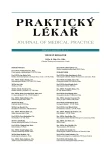Basics of social cognitive and affective neuroscience.
IV. Psychopathy
Authors:
F. Koukolík
Authors‘ workplace:
Oddělení patologie a molekulární medicíny, Fakultní Thomayerova nemocnice s poliklinikou, Praha
Published in:
Prakt. Lék. 2011; 91(4): 183-188
Category:
Editorial
Overview
The concept of psychopathy has a long tradition. The contemporary four-factor model describes psychopathy in
- interpersonal,
- affective,
- lifestyle, and
- antisocial variables.
The structural and functional neuronal basis of psychopathy has not been fully elucidated. There are two pathophysiological theories of psychopathy: somatic marker hypothesis and violence inhibition mechanism theory. Psychopathy is associated with dysfunction of the prefrontal-temporal-limbic system circuit.
Key words:
psychopathy, four-factor model, prefrontal-temporal-limbic circuit.
Sources
1. Abbot, A. Into the mind of a killer. Nature 2001, 410, 296-298. (Editorial k tématu: A danger to society. Nature 2001; 410: 287).
2. Ali, F., Amorim, I.S., Chamorro-Premuzic, T. Empathy deficits and trait emotional intelligence in psychopathy and Machiavellianism. Pers Individ Dif. 2009, 47, p. 758-762.
3. Anderson, S., Bechara, A., Damasio, H. et al. Impairment of social and moral behavior related to early damage in human prefrontal cortex. Nat. Neurosci. 1999; 2, p. 1032–1037.
4. Bechara, A., Damasio, H., Damasio, A.R. Emotion, decision making and the orbitofrontal cortex. Cerebral Cortex 2000, 10, p. 295-307.
5. Bechara, A., Tranel, D., Damasio, H. Characterization of the decision-making deficit of patients with ventromedial prefrontal cortex lesions. Brain 2000, 123, p. 2189-2202.
6. Bechara, A., Damasio, H., Damasio, A.R. Role of the amygdala in decision making. Ann. NY Acad. Sci. USA 2003, 985, p. 356-359.
7. Blair, R.J.R. A cognitive developmental approach to morality: investigating the psychopathy. Cognition 1995, 57, p. 1-29.
8. Blair, R.J.R., Colledge, E., Murray, I. et al. A selective impairment in the processing of sad and fearfull expression in children with psychopathic tendencies. J. Abnormal Child Psychology 2001, 29, p. 491-498.
9. Brower, M.C., Price, B.H. Neuropsychiatry of frontal lobe dysfunction in violent and criminal behaviour: a critical review. J. Neurol. Neurosurg. Psychiatry 2001,71, p. 720-726.
10. Buckholtz, J.W., Treadway, M.T., Cowan, R.L. et al. Mesolimbic dopamine reward system hypersensitivity in individual with psychopathic traits. Nat. Neurosci. 2010, 13(4), p. 419-421.
11. Cleckley, H. The mask of sanity. St.Louis: Mosby, 1976.
12. Damasio, A,R., Tranel, P.J., Damasio, H. Individuals with sociopathic behavior caused by frontal lobe damage fail to respond autonomically to social stimuli. Behav. Brain Res. 1990, 41, p. 81-94.
13. Damasio, H., Grabowski, T., Frank, R. et al. The return of Phineas Gage: Clues about the brain from the scull of a famous patient. Science 1994, 264, p. 1102-1105.
14. De Brito, S.A., Mechelli, A., Wilke, M. et al. Size matters: increases grey matter in boys with conduct problems and callous-unemotional traits. Brain 2009, 132(Pt 4), 831-832.
15. Damasio, A. Hledání Spinozy. Radost, strast a citový mozek. Praha: Dybbuk, 2003/2004, přel. F. Koukolík.
16. Dolan, M., Fullam, R. Face affect recognition deficits in personality-disordered offenders: association with psychopathy. Psychol. Med. 2006, 36, p. 1563-1569.
17. Eslinger, P.J., Damasio, A.R. Severe disturbance of higher cognition after bilateral frontal lobe ablation. Patient E. V. R. Neurology 1985, 35, p. 1731-1741.
18. Eslinger, P.J., Grattan, L.M., Damasio, H. et al. Developmental consequences of childhood frontal lobe damage. Arch. Neurol. 1992, 49, p. 764-769.
19. Goldberg, E. Jak nás mozek civilizuje. Čelní laloky a řídící funkce mozku. Praha: Karolinum, 2004, přeložil F. Koukolík, s. 151-168.
20. Hare, R.D. Psychopathy, affect and behavior. In: Cooke, D.J., Forth, A.E., Hare, R.D. (vyd.) Psychopathy. Theory, research and implications for society. Dordrecht: Kluver Academic Publishers 1998, p. 105-139.
21. Hare, R.D. The Hare Psychopathy Checklist-revised. Toronto: Multi Health System, 1991.
22. Kiehl, K.A., Smith, A.M., Hare, R.D. et al. Limbic abnormalities in affective processing by criminal psychopaths as revealed by functional magnetic resonance imaging. Biol. Psychiatry 2001, 50, p. 677-684.
23. Koenigs, M., Kruepke, M., Newman, J.P. Economic decision-making in psychopathy: a comparison with ventromedial prefrontal lesion patients. Neuropsychologia 2010, 48, p. 2198-2204.
24. Koukolík, F., Drtilová, J. Vzpoura deprivantů. Nové vydání. Praha: Galén, 2006.
25. Koukolík, F. Základy sociální, kognitivní a afektivní neurovědy. I. Úvod. Prakt. Lék. 2010, 92, s. 695-700.
26. Koukolík, F. Funkční systémy mozku. Praha: Galén, 2011 (v tisku).
27. Van Honk, J., Hermans, E.J., Pulman, P., et al. Defective somatic markers in subclinical psychopathy. Neuroreport 2002, 13, p. 1025-1027.
28. Viding, E., Blair, J.R., Moffitt, T.E., Plomin, R. Evidence for substantial genetic risk for psychopathy in 7-year-olds. J. Child Psychol. Psychiatry 2005, 46, p. 592-598.
29. Weber, S., Habel, U., Amunts, F. et al. Structural brain abnormalities in psychopaths - a review. Behav. Sci. Law 2008, 26, p. 7-28.
Labels
General practitioner for children and adolescents General practitioner for adultsArticle was published in
General Practitioner

2011 Issue 4
Most read in this issue
- Antihypertensives, antibiotics, analgesics, and other drugs frequently used in pregnancy
- Tracheal rupture after endotracheal intubation
-
Basics of social cognitive and affective neuroscience.
IV. Psychopathy - Experience of general practitioners with the Medical Assessment Service
